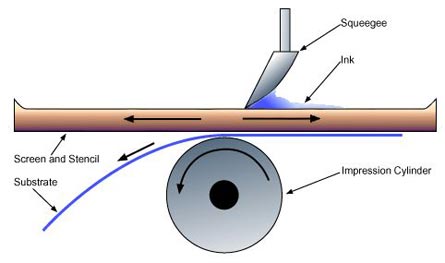Screen Printing
Screen printing has been used for centuries and although there have been many improvements with the technology, the process still consists of forcing ink through a stencil covered fabric or wire mesh which has been mounted in a sturdy frame.

The equipment costs for screen printing are lower than other printing processes, but the rate of production is usually slower. Manual screen printing can be accomplished with only a few simple items: a sturdy frame, screen fabric, stencils, squeegees, and ink.
Applications
Screen printing can be performed on almost any type of material including paper, glass, fabric, plastic, wood, and metal. Products as varied as clothing, signs, posters, circuit boards, mugs, and soft drink bottles can be printed using the process. Screen printing is very useful when an image needs to be wrapped around an object or when images need to be printed onto oddly shaped manufactured objects.

Screen Fabrics
Fabrics for screen printing are selected because of several properties. One type of fabric may be suitable for one application and not another. Fabrics are classified according to the following properties:
- Filament refers to the type of thread that makes up the fabric. The thread can be multifilament or monofilament of which monofilament provides the best quality. The multifilament threads produce images with more jagged edges than the monofilament thread, but they are not as expensive as monofilament.
- Mesh Count is the number of threads per linear inch. A higher mesh count produces finer details and higher quality in the product.
- Strength is determined by the diameter of the thread. A larger thread diameter will provide greater strength to the fabrics, but the print quality will decrease.
- Weave Patterns for screen printing fabrics are based on three types: plain, which can be used for most applications, gauze, which is selected for long runs because of its strength, and twill, which is chosen for its low cost and when quality is not an issue.
Most fabrics used for screens are made from one of the following materials:
- Silk used to be the most common fabric because of its durability, but it is not used as much today because other fabrics, especially synthetics, have proven to be as good or better and are less expensive.
- Organdy is inexpensive and is good for short and medium runs.
- Nylon is the most durable fabric (synthetic or natural). It is a good choice for print applications involving convex or concave surfaces
- Polyester is widely used for its durability and versatility.
- Metal Mesh is made of stainless steel, copper, bronze, or brass and is used when plastic substrates are printed with heated inks.
Stencil Types
Knife cut stencils are created with manual cutting and can be paper, water soluble, or lacquer soluble.
- Paper : Stencils cut from paper are used for basic designs and short runs.
- Water Soluble : Water soluble gelatin is cut away from the plastic base of the stencil. The cut away portions of the gelatin represent the image areas. The plastic base and remaining gelatin are placed on the screen material and water is used to adhere the gelatin layer to the screen. The plastic base can then be peeled off from the gelatin layer which remains adhered to the screen fabric.
- Lacquer Soluble : A lacquer soluble stencil is used much the same way as the water soluble stencil except that the stencil is adhered to the screen material with lacquer solvents.
Photographic stencils are made of photosensitive materials and require the use of film positives for exposure.
There are three types of photographic stencils: indirect, direct, and direct/indirect.
- Indirect : An indirect stencil is a photographic stencil which is produced independent of the screen fabric and is applied to the screen after exposure.
- Direct : A direct stencil is one in which the photosensitive material is applied to the screening fabric so that after exposure, the stencil becomes part of the fabric. It is very durable and is useful for long runs.
- Direct/Indirect : A direct/indirect stencil is a combination of the two stencil types. It lasts longer than an indirect stencil, but it cannot match its quality.
Ink
There is a wide variety of inks available for use with screen printing. The ink for some applications may need to be resistant to ultra-violet light or they may need to be scratch, fade, or chemical resistant for other applications. Most of the inks for screen printing are applied with a heavy coverage so the ink layer takes a long time to dry. The printed products can be air dried on racks if the number of printed pieces is small, but most often a heat source is used to speed up the drying, especially if the screen printing is performed with higher speed, automatic equipment.
Press Types
Most large volume screen printing is performed on automatic printing equipment which makes the process much more efficient and cost effective. Manual screen printing is still used for many of the smaller runs or for specialized applications.

The basic press types are listed below:
- Flatbed : A flatbed press is used for printing on flat substrates.
- Flatbed Cylinder : A flatbed cylinder press is much like a letterpress flatbed cylinder press and is used for longer runs of flat applications.
- Cylinder : A cylinder press is used for printing on round or oval objects.
- Textile : T-shirts and other clothing items are printed on a textile press.
- Precision Flatbed : One of the major uses for the precision flatbed press is circuit board printing.
- Rotary : Higher production rates are a benefit of the rotary presses. The ink is pumped into the printing cylinder and a squeegee on the inside of the cylinder controls the flow of the ink.